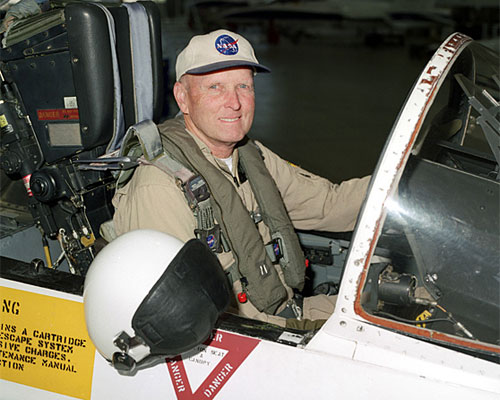Long-time Dryden research pilot and former astronaut Gordon Fullerton flew his last NASA flight in a Dryden F/A-18 this morning, Dec. 21. Fullerton, who is retiring Dec. 31 after a more than 49-year career with NASA and the Air Force, and Dryden research pilot Jim Smolka took off about 9:30 a.m. on a 75- to 90-minute pilot proficiency formation flight with another Dryden F/A-18 and a Dryden T-38.
Gordon was honored with a water-arch provided by two Fire/Rescue trucks from the Air Force Flight Test Center. All members of the Dryden family were encouraged to come out on the back ramp behind B/4800 to greet Fullerton upon his return.
A retired Air Force colonel, Fullerton was assigned to NASA's astronaut corps in 1969 after the Air Force Manned Orbital Laboratory program to which he had been assigned was canceled. Fullerton served on the support crews for the Apollo 14, 15, 16 and 17 lunar missions, and was later assigned to one of the two flight crews that piloted the space shuttle prototype Enterprise during the Approach and Landing Test program at Dryden. He then logged some 382 hours in space when he flew on two early space shuttle missions, STS-3 on Columbia in 1982 and STS-51F on Challenger in 1985. He joined the flight crew branch at Dryden after leaving the astronaut corps in 1986.
At Dryden, Fullerton was project pilot on a number of high-profile research efforts, including the Propulsion Controlled Aircraft, the high-speed landing tests of space shuttle landing gear components installed on a modified Convair 990 jetliner, the C-140 JetStar Laminar Flow Control, F-111 Mission Adaptive Wing, F-14 Variable Sweep Flow Transition, X-29 vortex flow control, the Russian Tu-144LL supersonic transport and Dryden's F-18 Systems Research Aircraft. He also was project pilot for a number of research efforts involving Dryden's now-retired B-52B mothership, and piloted NASA's DC-8 science laboratory on world-wide missions. Fullerton also served as Associate Director of Flight Operations and chief of the flight crew branch in recent years.












